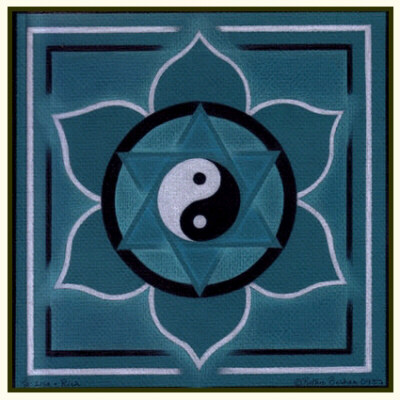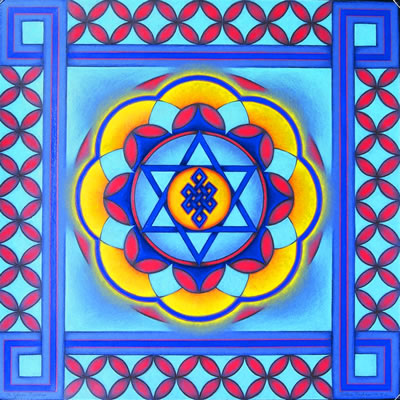Joel Stanley
Pinson doesn't explain these subtleties, and instead makes the cardinal error of defining another tradition from another one's perspective. Pinson's analysis of other traditions is often quite sophisticated and in parts quite accurate, but he portrays these 'Eastern Religions' within a purely Jewish discourse. Not once does Pinson quote or reference a text from another religion. Instead we get demeaning comments such as:
| The Zohar teaches that the great sages of the East inherited their wisdom from Abraham . . . Originally these teachings were pure, though later on they were drawn to many (idolatrous) sides with this wisdom. (242) |
 This may well be what the Zohar teaches, but is it historically true? If so, Pinson should prove it. If not, he should engage with this text of the Zohar, in all its ambiguity. Instead, Pinson repeats the often-heard folk etymology that the Sanskrit word Brahman (which essentially means the One, the Infinite) is derived from the word Abraham. His evidence for this is not a sound linguistic source but rather Rabbi Menasha Ben Israel, Nishmat Chayim.
This may well be what the Zohar teaches, but is it historically true? If so, Pinson should prove it. If not, he should engage with this text of the Zohar, in all its ambiguity. Instead, Pinson repeats the often-heard folk etymology that the Sanskrit word Brahman (which essentially means the One, the Infinite) is derived from the word Abraham. His evidence for this is not a sound linguistic source but rather Rabbi Menasha Ben Israel, Nishmat Chayim.
It is true that I've so far only picked on one chapter and, furthermore, the one most concerned with comparing Jewish doctrines with non-Jewish ones. But it nonetheless illustrates an error of method that runs throughout the book, namely that of assertion without method of proof.
The Buddha told his potential followers not to take anything on his word; he said they should try out the techniques and test whether what he said is true. In contrast, Pinson encourages his readers to distrust their own experiences, but does not offer a way to evaluate whether they are true. So he states:
| It is important to note that erroneous parallels can be drawn between what these great saints experienced and what most people experience. The truth is that for most, these experiences are inauthentic and purely imaginative, while the authentic experience is one where there is actual spiritual movement inward and upward. (147) |
Now, if Pinson is warning against crediting meditative visions with too much reality, this is an understandable caution, and one found among all responsible teachings. But Pinson does not explain how to distinguish "inauthentic" experiences from real ones. He gives the meditator no apparatus to experience the relevant techniques and make personal evaluations and discoveries.
Throughout, the book focuses on the broad theory of Jewish meditation – and neglects the how-to. Pinson mentions a large variety of Jewish meditation practices, ranging from mantra recitals of Talmud or Biblical verses to lying in bed visualising one's own self-sacrifice in divine flames. What is lacking is a sense that this is something his readers might like to try themselves. Most people coming fresh to a new form of meditation (or to meditation itself) need to be guided every step of the way. Here, too many of the meditation techniques outlined by Pinson remain just outlined. For example, the section on dancing meditation refers to the Sheim HaVaYa dance, "the Tetragrammaton dance", and explains it as follows:
| By dancing in a certain formation, the Chassid is acting out, on a physical plane, this lofty name. And by doing so, he is making the concept real and creating a unification with that name. When one dances with this in mind, the act becomes most noble and elevated. (136) |
What is this "certain formation"? How can I do this dance myself? Pinson doesn't say. Perhaps no one knows the exact details of the Sheim HaVaYa dance, but a more creative thinker would propose a way to explore the technique today. One gets a sense that Pinson is trying to be a Rabbi Eliezer ben Hyrkanos, who, according to Pirkei Avot, was like a "cemented cistern that never loses a drop". In other words, he is a vessel, a reliable carrier of tradition and wisdom. Not only does he never lose a drop; he rarely adds one either.
The book fares best in the section on using Jewish prayer as a meditative method. Here again we begin with a general assertion:
| With each section of prayer, one attains a more refined state of consciousness; a higher level of soul is achieved and a more elevated world is revealed . . . Prayer has a transformative potency that can change a person from being egotistical to Godly, from being in a limited confined state, to an elevated expansive one. (110 & 114) |
However, thankfully for the many people in the non-Orthodox world who are either unfamiliar with the intricate details of kavanah (intention) or have sat, like Franz Kafka, in synagogue services to find them "a mere nothing, a joke – not even a joke", there is more: Pinson goes on to describe themes on which one should concentrate during prayer. He outlines the main building blocks of the morning shacharit service, and relates these four sections to the kabbalistic worlds of asiyah, yetzirah, beriah and atzilut. He goes on to associate these worlds with different modes of consciousness: body/matter consciousness, emotional consciousness, mental-intellectual consciousness and non-dualism respectively. Prayer, he says, is a ladder to lead the worshipper closer to the Source until there is "a complete abandonment of one's sense of self as a separate, independent existence" (113). Pinson also gives general intentions for the saying of the different sections. So to take Pisukei D'zimrah, the verses of praise that come before the reading of the Shema: "one continuously praises the Creator for the miracles of creation and the wonders performed throughout the ages." (111)
 This part of the book is an excellent, and scholarly, resource. Perhaps appropriately, it is really about prayer - central to Jewish religious life - not meditation per se. When Pinson returns to meditation proper, we are left without guidance. I kept expecting the author to include a section on the basics of meditation, but it only came right at the very end, across two pages, eight steps, after the litany of references and practices that make up the main part of the book. The result is disempowering.
This part of the book is an excellent, and scholarly, resource. Perhaps appropriately, it is really about prayer - central to Jewish religious life - not meditation per se. When Pinson returns to meditation proper, we are left without guidance. I kept expecting the author to include a section on the basics of meditation, but it only came right at the very end, across two pages, eight steps, after the litany of references and practices that make up the main part of the book. The result is disempowering.
Pinson's book is subtitled Exploring the Jewish Meditative Paths. If by "exploring" one means looking with the eyes of a scholar, cataloguing and identifying sources on meditation, then the book is a great success. The book also works if "exploring" means peering cautiously with the eyes of a traditional Jew, seeking only the words that the tradition explicitly contains, and doubting that any wisdom from "outside" could have merit. Yet if one has a broader meaning – say, exploring one's own spiritual path, or one's own consciousness – the potential is highly limited. Perhaps these journeys, guided not by authority but by experience and curiosity, stray too far from where some Jews allow themselves to go.

A review of Mentsh: On Being Jewish and Queer
May, 2005
May, 2005
April, 2005
April, 2005
March, 2005
A review of Esther Kaplan's With God on their Side
March, 2005
Walking through The Gates
March, 2005
The last words of Israel's soldier-poet
January, 2005
A bereaved mother, a rabbi, and a therapist look at dark emotions
December, 2004
November, 2004
What's lost and found in two new translations of the psalms
September, 2004
July, 2004
Robert Meeropol's An Execution in the Family
January, 2004
Between contemplation and affirmation
Bernard Henri-Levy on the death of Daniel Pearl
A review of Douglas Rushkoff's Nothing Sacred
January, 2004
Two Zeek editors discuss running, spirituality, and Running the Spiritual Path
December, 2003
September, 2003
July, 2003
Four modern Orthodox breakbeat musicians on Jewish art
May, 2003



Golden Calf
Jacob J. Staub
Israel on Campus
A Conversation with Sam Brody and Zach Gelman
Samaria for Rent
Margaret Strother-Shalev
Does Mysticism Prove the Existence of God?
Jay Michaelson
Patrolling the Boundaries
of Truth
Joel Stanley
The Wheel World
Dan Friedman
Archive
Our 700 Back Pages
Zeek in Print
Summer 2005 issue now on sale
About Zeek
Mailing List
Contact Us
Subscribe
Tech Support
Links
Limited Time Offer
Subscribe now and get
two years of Zeek for
25% off regular price.
Click this button
to purchase:
From previous issues:
Erev
What the World is...
When I Met Humility, I Saw Letters
Temima Fruchter
Jay Michaelson
Abraham Mezrich
 Email us your comments
Email us your comments